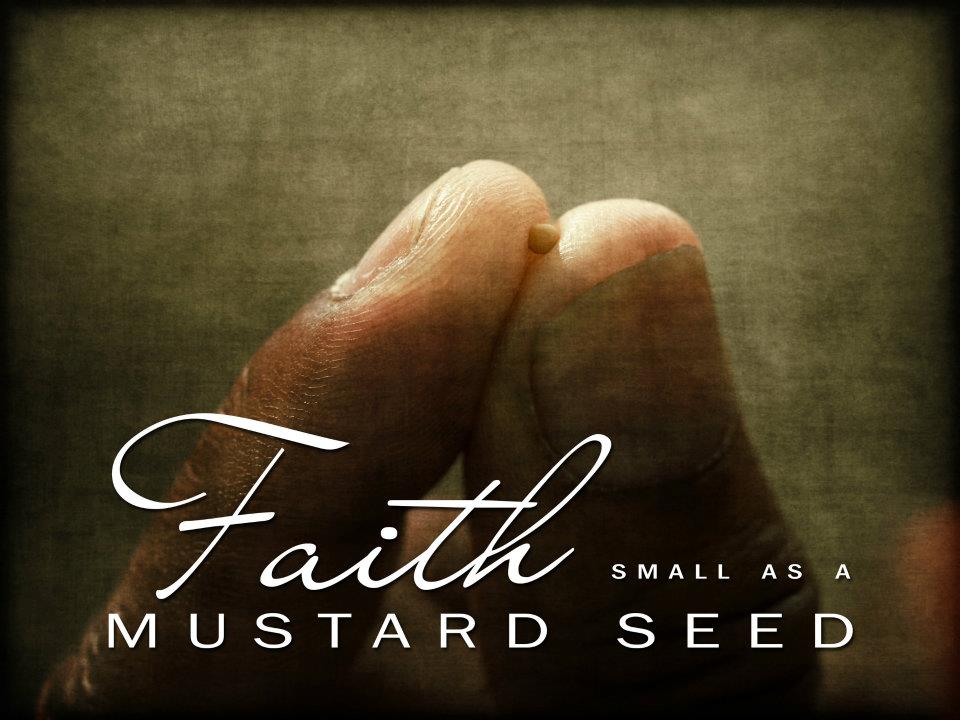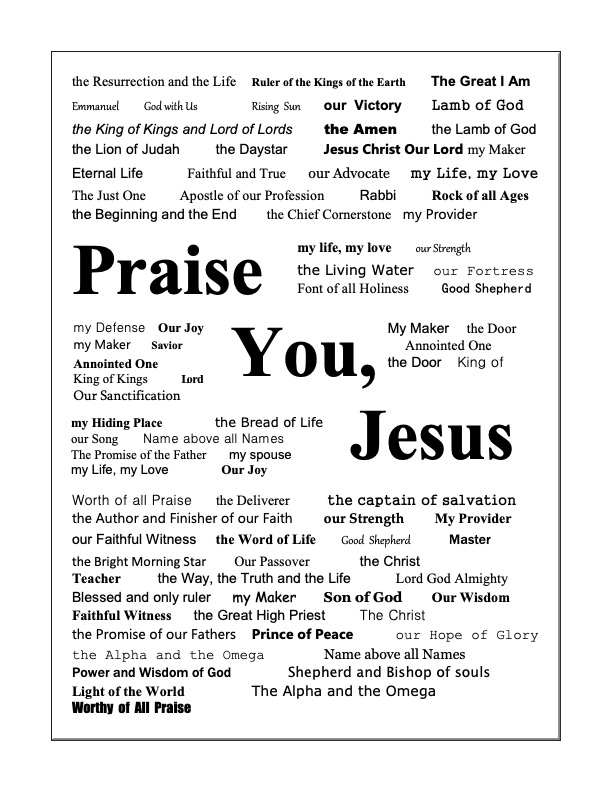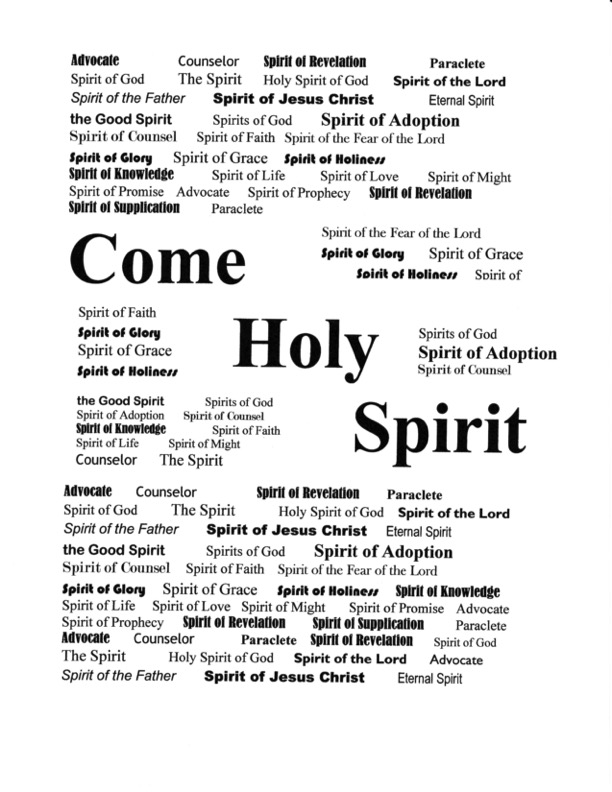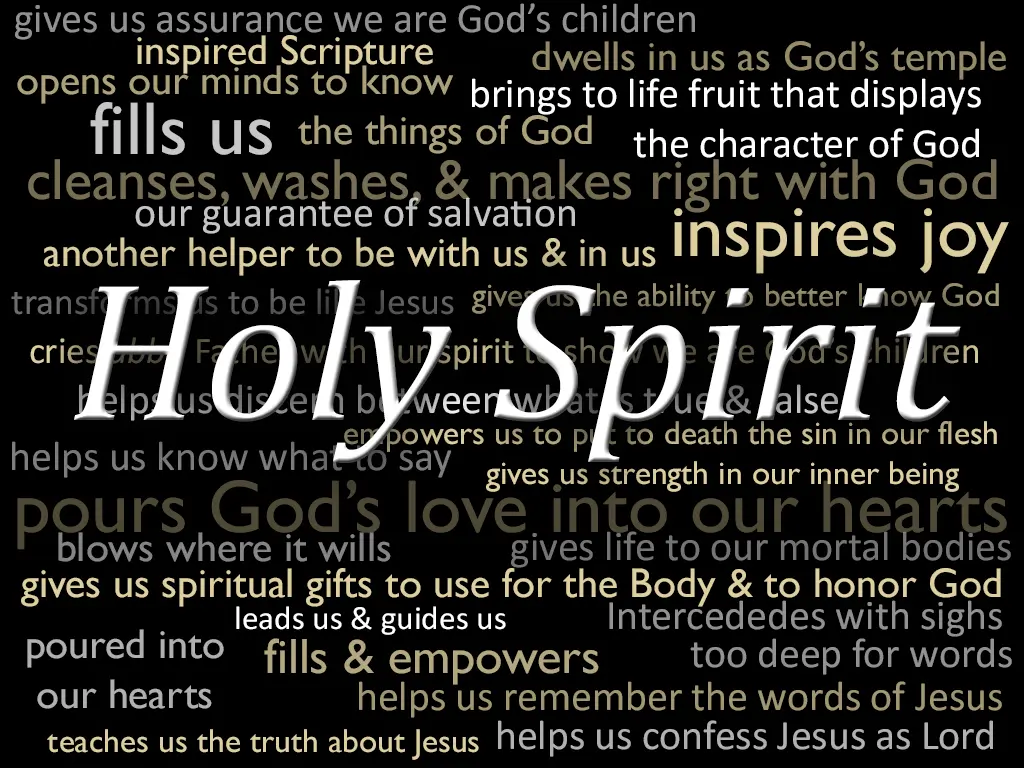Prayer Resources
Prayer Resources provides several specific formal prayers to the Holy Spirit, the Armor of God and discussion on praying and the role of faith in prayers.
Overview:
Prayers to the Holy Spirit
These are formal prayers to the Holy Spirit.

Novena to the Holy Spirit
PENTECOST NOVENA
Wait for the Promise of the Father
“While meeting with them, he enjoined them not to depart from Jerusalem, but to wait for ‘the promise of the Father about which you have heard me speak; for John baptized with water, but in a few days you will be baptized with the Holy Spirit.’” Acts 1:4-5
The apostles waited, in obedience to Jesus, not knowing what would happen, or how long they would wait.
“When they entered the city they went to the upper room where they were staying… All these devoted themselves with one accord to prayer, together with some women, and Mary the mother of Jesus, and his brothers.” Acts 1:13-14
The apostles devoted themselves to prayer with Mary, the mother of Jesus. They prayed for nine days and on the tenth day a noise like a strong driving wind filled the entire house in which they were.
Let us too wait on the Lord to be baptized in the Holy Spirit, to be renewed in the outpouring of the Spirit on Pentecost. Let us devote ourselves to prayer for nine days, a Novena leading up to the outpouring of the Spirit this Pentecost. Here are links to four novenas, or you may have a favorite novena to the Holy Spirit. Let’s devote ourselves with one accord to prayer, waiting for the promise of the Father.
— Western Washington Catholic Charismatic Renewal
Jesus and the Holy Spirit
Reading the names that describe different characteristics of Jesus and the Holy Spirit can be a resource for meditation and/or contemplation.
Put on the Whole Armor of God
The text about the “Armor of God” is found in the New Testament in the Letter to the Ephesians. It can be used by followers of Christ as a daily prayer to draw closer to our Lord. Over time, you may find that it is also a guideline as to how we can and should live our life. The text of the scripture is:
Battle against Evil.
Finally, draw your strength from the Lord and from his mighty power. Put on the armor of God so that you may be able to stand firm against the tactics of the devil.
For our struggle is not with flesh and blood but with the principalities, with the powers, with the world rulers of this present darkness, with the evil spirits in the heavens.
— New American Bible: Revised Edition (NABRE), 2011, Ephesians 6:10-12
The following verses tell us how to put on the armor of God.
Therefore, put on the armor of God, that you may be able to resist on the evil day and, having done everything, to hold your ground. So stand fast with your loins girded in truth, clothed with righteousness as a breastplate, and your feet shod in readiness for the gospel of peace. In all circumstances, hold faith as a shield, to quench all (the) flaming arrows of the evil one. And take the helmet of salvation and the sword of the Spirit, which is the word of God.
— NABRE, 2011, Ephesians 6:13-17
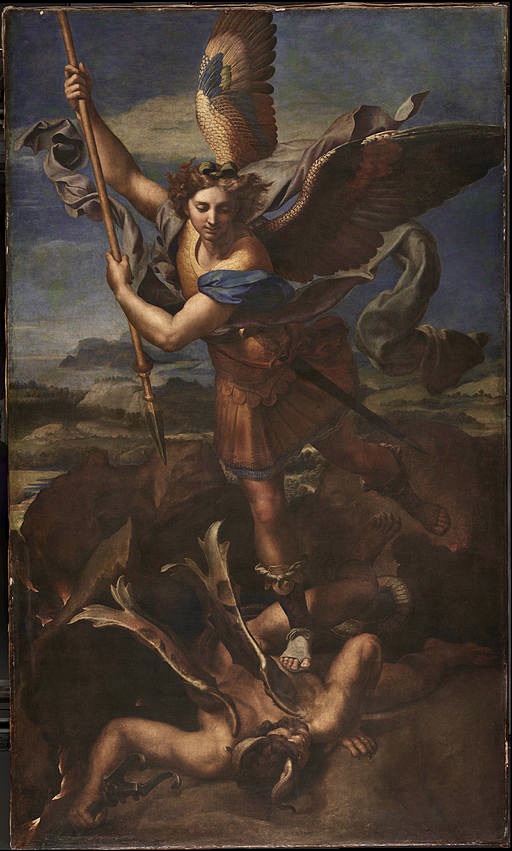
St. Michael Vanquishing Satan by Raffaelio Sanzio, 1518
The next verse in this reading encourages us to pray in tongues.
With all prayer and supplication, pray at every opportunity in the Spirit.
— NABRE, 2011, Ephesians 6:18a
The painting of St. Michael the Archangel provides an image of the battle we face each day, as we strive to “stand firm” with our Lord. Many find that if you pray this prayer frequently, it becomes not just the “armor for battle with the evil one”, but rather a way of life with God.
What is Prayer?
Prayer is defined in the Catechism of the Catholic Church (CCC) as:
The elevation of the mind and heard to God in praise of his glory; a petition made to God for some desired good, or in thanksgiving for a good received, or in intercession for other before God. Though prayer the Christian experiences a communion with God through Christ in the Church.
— Catechism of the Catholic Church (CCC), 2000, Glossary
Catechism further describes prayer as communion with God.
In the New Covenant, prayer is the living relationship of the children of God with their Father who is good beyond measure, with his Son Jesus Christ and with the Holy Spirit. The grace of the Kingdom is ‘the union of the entire holy and royal Trinity . . . with the whole human spirit. Thus, the life of prayer is the habit of being in the presence of the thrice-holy God and in communion with him. This communion of life is always possible because, through Baptism, we have already been united with Christ. . . . Its dimensions are those of Christ’s love.
— CCC, 2000, para. 2565

One form of prayer is mediation. The Catechism provides the following:
There are as many and varied methods of meditation as there are spiritual masters. Christians owe it to themselves to develop the desire to meditate regularly, lest they come to resemble the three first kinds of soil in the parable of the sower. But a method is only a guide; the important thing is to advance, with the Holy Spirit, along the one way of prayer: Christ Jesus.
— CCC, 2000, para. 2707
Meditation engages thought, imagination, emotion, and desire. . . . Christian prayer tries above all to meditate on the mysteries of Christ, as in lectio divina or the rosary. This form of prayerful reflection is of great value, but Christian prayer should go further: to the knowledge of the love of the Lord Jesus, to union with him.
— CCC, 2000, para. 2708
The Church has long recognized the practice of meditation and contemplation in prayer. It calls the practice “Lectio Divna.” This form of prayer is described on the USCCB website. Here is a summary statement. For more information, please follow the link below.
Spiritual reading of Sacred Scripture, especially the Gospels, is an important form of meditation. This spiritual reading is traditionally called lectio divina or divine reading. Lectio divina is prayer over the Scriptures.
— USCCB, Meditation
What is the Role of Faith in Prayer?
The Catechism shows us the link between our prayer to God and our faith.
“No one can say ‘Jesus is Lord’ except by the Holy Spirit.” “God has sent the Spirit of his Son into our hearts, crying, ‘Abba! Father!”‘ This knowledge of faith is possible only in the Holy Spirit: to be in touch with Christ, we must first have been touched by the Holy Spirit. He comes to meet us and kindles faith in us. By virtue of our Baptism, the first sacrament of the faith, the Holy Spirit in the Church communicates to us, intimately and personally, the life that originates in the Father and is offered to us in the Son.
— CCC, 2000, para. 683
We find the definition of faith in Scripture.
Faith is the realization of what is hoped for and evidence of things not seen. — NABRE, 2011, Hebrews 11:1
The rest of that Chapter documents numerous examples from the Old Testament where key individuals acted in faith, based on the word of God, about things that seemed impossible.
The Catechism defines faith as:
Faith: Both a gift of God and a human act by which the believer gives personal adherence to God who invites his response, and freely ascents to the whole truth God has revealed. It is this revelation of God which the Church proposed for our belief, and which we profess in the Creed, celebrate in the sacraments, live by right conduct that fulfills the twofold commandment of charity (as specified in the ten commandments), and respond to in our prayer of faith. Faith is both a theological virtue given by God as a grace, and an obligation which flows from the first commandment of God. — CCC, 2000, Glossary
Faith then becomes the engine that drives our prayers to God. It is our response to the grace of God, that we believe His Word and are willing to take action as the Holy Spirit prompts.
